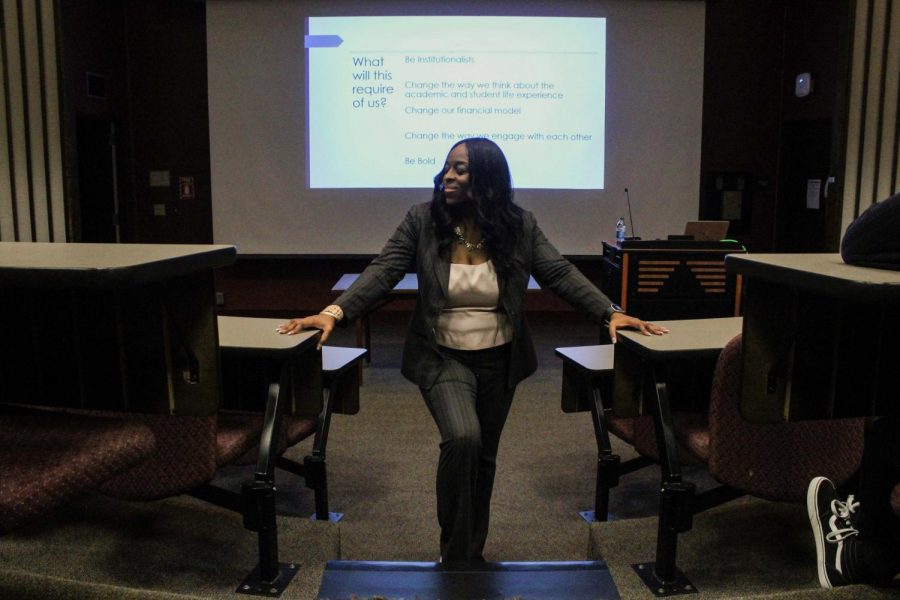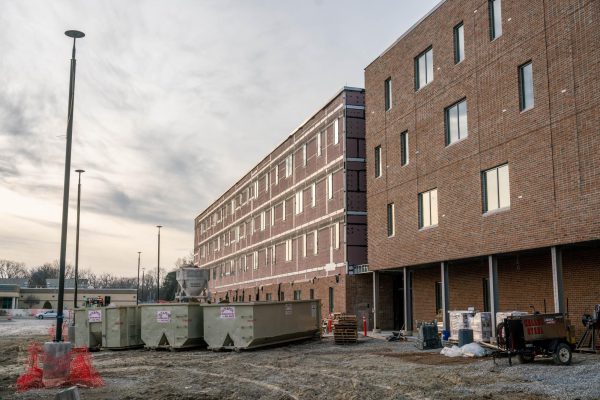Ambar Details Finances, Solutions to Students
President Carmen Ambar presenting to students regarding Oberlin’s financial deficit.
President Carmen Ambar presented to students about Oberlin’s current budgetary state and answered subsequent questions Wednesday evening in King Building. Ambar mentioned how she intends to answer the financial deficit in student-specific ways, including the eventual closing of Dascomb Hall’s cafeteria and older Village Housing Units.
The presentation is the 10th in a series of 11 that Ambar has been giving to different groups on campus. The president said that financial decisions made over the past 11 years, including the construction of the Science Center and Kahn Hall, have contributed to the deficit Oberlin sees today. In 2007, Oberlin began using its endowment funds differently than it had previously. Rather than spending about five percent of endowment funds annually — as it had prior, and as is typical for our peer institutions — Oberlin started withdrawing additional money from the endowment in “extraordinary dollars,” to use Ambar’s language, which has accumulated to $80 million over the past decade.
To address the deficit, which currently sits at $3 million but is projected to increase to $9 million next year and to $20 million in following years, Ambar suggested adjusting housing and dining facilities to fit the smaller classes that Oberlin has enrolled in recent years — in the past 10 years, the College has only hit its enrollment goal of 2,950 students twice. Since 66 percent of Oberlin’s revenue comes from tuition, student enrollment is a significant factor in the resources Oberlin has to work with. Ambar said that in light of the results of last semester’s campus dining review, closing Dascomb’s dining hall will help the College adjust to its financial situation.
“There was a dining study that was done — students were surveyed about their dining experience,” Ambar said. “Essentially, the lowest numbers were in Dascomb … first of all, and then it was rated as the least quality food. … We can’t contain all the dining halls, so how do we make this choice? We looked at numbers of people going to the facilities, the quality of the food. … The other piece was what we might be able to do with that space, that we can bring some other things into central campus that we need.”
Despite the results from the student survey, according to statistics previously reported (“Students, CDS Workers Protest Bon Appétit, The Oberlin Review, May 5, 2017), Dascomb serves a significant number of students, averaging at 500 for lunch and 350 for dinner, while Stevenson Dining Hall serves 600–800 for both lunch and dinner, and Lord-Saunders Dining Hall serves 150 for dinner.
At the presentation, Ambar announced that the Board of Trustees had already decided to increase the 2018–2019 school year tuition by three percent, but she said that this rate and the cost of an Oberlin education will be in line with the College’s peer institutions. Ambar added that students and families who are in the $70,000-and-under income bracket will not be affected by the tuition hike.
“This sounds like a terrible thing to say, because I know it’s really expensive to go here, and I know many of you and your families are sacrificing to make it happen, so don’t think I don’t appreciate that,” Ambar said. “But what has happened to tuition here at Oberlin … is that over time, with our competitors, we really kind of bunched up, right? The tuition cost here is pretty similar to what we see at Vassar or Amherst or Kenyon or Macalester or Barnard.”
College junior and Student Senate Chair Kameron Dunbar finds the three-percent tuition increase reasonable.
“One thing President Ambar challenges us to [do] is to think from an institutional perspective, and as someone who’s been involved in student government for a long time, I think that I have a good idea of the big picture of Oberlin’s political and economic landscape, and from that … I do think it’s an appropriate increase,” Dunbar said, adding that it is important that the hike will not hurt low-income families.
Other changes to address the deficit that Ambar offered at the presentation included asking the General Faculty Committee to consider five to 15 percent reductions in faculty and staff, looking into further Voluntary Separation Incentive Programs as well as the consolidation of buildings that are not being used to full capacity.
In the meantime, Ambar has pushed for the College to undergo an external review to gain further insight about how to address its financial situation most effectively. In the long term, a larger analysis-focused group will be assembled to strategize permanent changes to ensure the longevity of the College. Approximately half of the group will consist of faculty, with the other half composed of a combination of staff, trustees, and students with the aim of creating a greater level of transparency moving forward.
Amid the larger structural transformations, Ambar added that she hopes to decrease smaller expenses for students, such as removing coin-operated laundry machines.
“One of the things that we’re going to do next year is we’re going to eliminate the coin-operating machines in the resident halls so you guys don’t have pay for laundry,” she said. “We’re trying to eliminate some of the costs of these smaller things.”
After the presentation, students asked questions on topics ranging from the fate of union worker jobs, where the Oberlin Student Cooperative Association sits in Oberlin’s future, and how the dining system will be rearranged to accommodate Dascomb’s eventual closure. Ambar said that although different employment positions and OSCA — which about a fifth of students are a part of — are on the table for restructuring discussions, she does not know what further review will suggest in the future.
“We’re just going to have to think about it,” Ambar said in regards to students dining and housing in OSCA. “I’m not saying that we have to get rid of everything like that; I’m saying we just have to figure it out, because we have to think about the long-term sustainability of the institution.”
Ambar added that counseling, student health, or some combination of student wellness offices may replace Dascomb’s dining space, and that the other dining halls will adjust hours to accommodate meals like breakfast, which Dascomb and the Science Center cart currently provide on weekdays.
Dunbar said that he thought the Q&A went well, and that students were honest with their questions.
“I think the people asked about the things they found important,” Dunbar said. “I think people also asked things that maybe were in the heads of other folks — so, students asked how changes might affect unionized staff — and I thought that that was particularly important because Obies care about the well-being of other people.”
College senior Robin Cornell said that despite the difficulty of transparently explaining Oberlin’s budgetary situation to students, he appreciated Ambar’s presentation.
“I thought [Ambar] did a really good job in conveying the information and conveying controversial and tough aspects of what she had to get through,” Cornell said.
College sophomore Brian Smith said that in coming to Wednesday’s presentation, he wanted to hear the financial state and Ambar’s plan, adding that he was willing to trust the president.
“There seems to be a lot of worry around budgeting and the campus and what’s happening, and with worry comes rumors, so I’m here to hear what’s fact and what’s fiction and what’s the plan for Oberlin,” Smith said. “But at this point I feel like I trust Ambar.”







